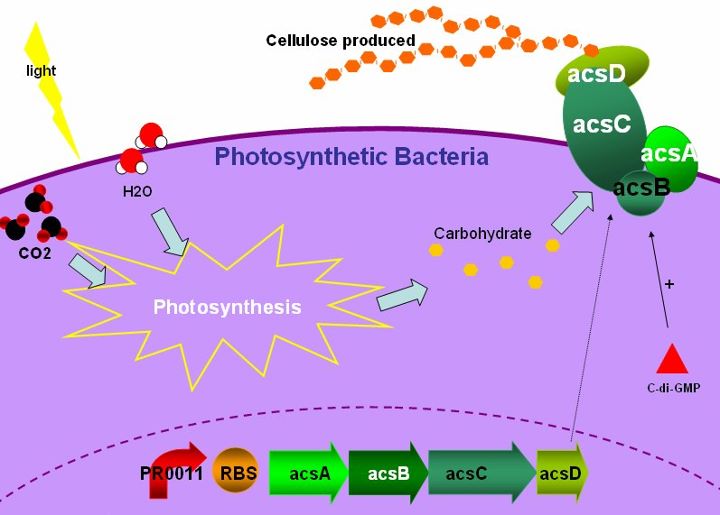Team:TzuChiU Formosa/Project/PhotoPaper
From 2011.igem.org
(→Overview) |
|||
| Line 37: | Line 37: | ||
<br><font size=4><b>a. about cellulose biosynthesis</b></font> | <br><font size=4><b>a. about cellulose biosynthesis</b></font> | ||
<br> | <br> | ||
| - | <br><font size=4><b>b. acs operon</b></font> | + | <br><font size=4><b>b.about acs operon</b></font> |
<br> | <br> | ||
| + | <i>Gluconacetobacter hansenii</i> ATCC23769 has been characterized as a model organism for cellulose biosynthesis. The cluster of genes which play the role of producing cellulose is acs operon. It contains three major genes, acsAB, acsC and acsD, and the final product is cellulose synthase. The acsAB catalyzes the formation of bacterial cellulose; acsA is the catalytic subunit which utilizes UDP-glucose to form the basic unit of cellulose; while acsB provide the regulatory subunit which has a cyclic di-GMP binding domain. The acsC gene is the main composite in the formation of the membrane complex of cellulose synthase and proposed to be involved in the export of the polymer across the bacterial cell wall.The acsD gene is involved in the crystallization of the mature cellulose by cleaves the intrastrand ß-1,4 linkages in the cellulose chain and is proposed to have a role in the release of the growing polymer from the cell. | ||
Revision as of 08:00, 5 October 2011


Photopaper
Abstract
For most countries, paper-making has been a traditional but indispensable industry. Wood pulp is the major raw material for paper-making ,moreover,the complicated processes toward paper-making may contribute to environmental pollution. Acetobacter xylinum is a bacterium which produces bacterial cellulose. It has an acs operon, consisting of genes that called acsAB, acsC, and acsD. These genes interact with each other and synthesize cellulose synthase, an enzyme that transforms UDP-glucose into cellulose. What we want to do is to choose cyanobacteria which provides glucose through photosynthesis. Therefore, we want to use cyanobacteria as the host, then introduce the acs operon genes in it and produce bacterial cellulose by expressing this series of genes. With manufacturing processes, we believe this project can develop into a new and eco-friendly technology of papermaking.
Background
a. about cellulose biosynthesis
b.about acs operon
Gluconacetobacter hansenii ATCC23769 has been characterized as a model organism for cellulose biosynthesis. The cluster of genes which play the role of producing cellulose is acs operon. It contains three major genes, acsAB, acsC and acsD, and the final product is cellulose synthase. The acsAB catalyzes the formation of bacterial cellulose; acsA is the catalytic subunit which utilizes UDP-glucose to form the basic unit of cellulose; while acsB provide the regulatory subunit which has a cyclic di-GMP binding domain. The acsC gene is the main composite in the formation of the membrane complex of cellulose synthase and proposed to be involved in the export of the polymer across the bacterial cell wall.The acsD gene is involved in the crystallization of the mature cellulose by cleaves the intrastrand ß-1,4 linkages in the cellulose chain and is proposed to have a role in the release of the growing polymer from the cell.
System Design
Result
Reference
The Experiments
Overview
 "
"
